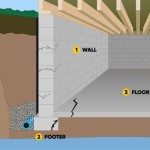How to Put Up Walls in a Basement
Finishing a basement can be a great way to add extra living space to your home. One of the first steps in finishing a basement is putting up walls. This can seem like a daunting task, but it is actually quite simple if you follow the right steps.
In this article, we will walk you through the essential aspects of putting up walls in a basement. We will cover everything from choosing the right materials to framing the walls to finishing them off.
Choosing the Right Materials
The first step in putting up walls in a basement is choosing the right materials. There are a few different types of materials that can be used, but the most common is drywall. Drywall is a type of gypsum board that is made up of a layer of gypsum sandwiched between two layers of paper. Drywall is easy to install and finish, and it is also relatively inexpensive.
If you are putting up walls in a basement that is prone to moisture, you may want to consider using a different type of material, such as cement board or green board. Cement board is a type of backer board that is made up of a mixture of cement and sand. Green board is a type of drywall that is treated with a mold-resistant coating.
Framing the Walls
Once you have chosen the right materials, you can begin framing the walls. Framing is the process of building the framework of the walls. The framework is made up of studs, which are vertical pieces of wood that are spaced 16 inches apart. The studs are then covered with drywall or another type of wallboard.
To frame a wall, you will need to first mark the location of the studs on the floor. You can do this by using a chalk line or a laser level. Once you have marked the location of the studs, you can begin installing them. Studs are typically installed using a nail gun or a hammer and nails.
Finishing the Walls
Once the walls are framed, you can begin finishing them. The first step in finishing the walls is to install drywall or another type of wallboard. Drywall is installed by screwing it into the studs. Once the drywall is installed, you will need to tape and mud the seams between the sheets of drywall. Taping and mudding is a process of applying a layer of joint compound to the seams between the sheets of drywall. This helps to create a smooth, seamless surface.
Once the drywall is taped and mudded, you can begin painting or wallpapering the walls. Painting is the most common way to finish walls, but wallpaper can also be a good option. If you are painting the walls, you will need to first apply a coat of primer. Primer helps to create a smooth, even surface for the paint to adhere to.
Putting up walls in a basement is a relatively simple process if you follow the right steps. By following the tips in this article, you can put up walls in your basement that will look great and last for years to come.

Basement Framing How To Frame Your Unfinished

This Is How To Frame A Basement According Mike Holmes Hgtv

Tips For Framing Basement Walls Semigloss Design

Insulating And Framing A Basement

Tips For Framing Basement Walls Semigloss Design

Framing Basement Walls How To Build Floating

Tips For Framing Basement Walls Semigloss Design

Framing Basement Walls How To Build Floating

Framing A Basement In Denver Elkstone Basements

Building A Wall In Place Fine Homebuilding
See Also








